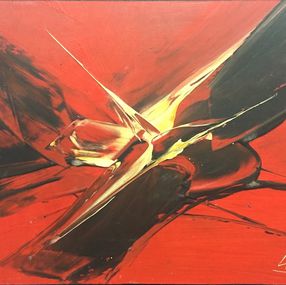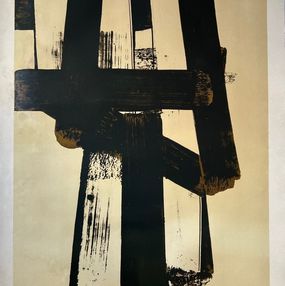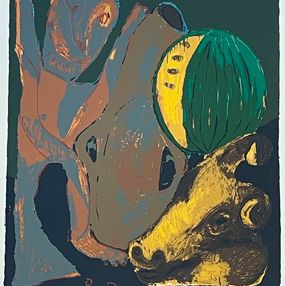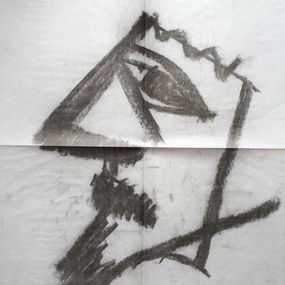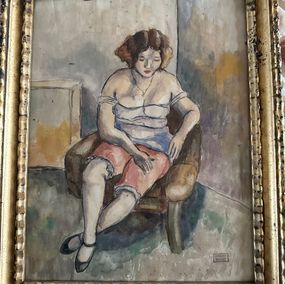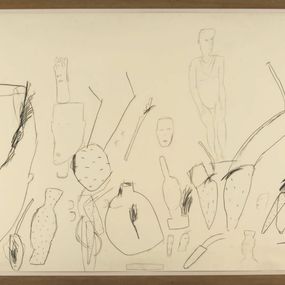
Casida de la mano imposible,
1969
Manuel Viola
Print : lithography
45.2 x 33.5 cm 17.8 x 13.2 inch
One of the last works available by this artist
Second NOT DISPLAYED BLUR TEXT
Free returns within 14 days
Authenticity guaranteed
Learn moreSecure payment
About the artwork
Type
Numbered and limited to 180 copies
1 copy available
Signature
Hand-signed by artist
Authenticity
Invoice from the gallery
Medium
Dimensions cm • inch
45.2 x 33.5 cm 17.8 x 13.2 inch Height x Width x Depth
Support
Framing
Not framed
Tags
Artwork sold in perfect condition
Artwork location: France
Original lithograph numbered and signed by hand.
Limited edition of 180 copies (145/180)
Hand stamped by the master Manuel Repila in three inks around the work of the poet Federico Garcia Lorca.
Stored flat. Good condition.
About the seller
AME • France
Artsper seller since 2015
Vetted Seller
This seller rewards your purchases of multiple artworks
Collector’s Guide
Imagine it at home

Presentation
Signature of Manuel Viola
Contents [hide]
1 Biography
2 Awards and decorations
3 References
4 External links
Biography [edit]
Viola had an autodidact education, although it began university studies of Philosophy and Letters in Barcelona, ??that were truncated with the beginning of the civil war. From these years his first drawings and his beginnings in the field of literature and art date, because he is cofounder in Lérida of the surrealist magazine Art.
Together with such companies as Lorca, J. V. Foix, Alberti or Cocteau, Viola published poems of clear super-royalist ascendancy: "the red wine of the air curls / in a naked horse skeleton" 1
In 1936 he formed part of the ADLAN group (Friends of the New Arts) in Barcelona and in May of the same year he wrote with the art critic Magí Albert Cassanyes the manifesto of the Legicofobista Exhibition. 2 Viola related the exhibition to surrealism, and pointed out that this movement was a kind of subset of logophobeism. In his view, poetry was the portal that would lead artists to a new form of knowledge.3
Of an anarchist spirit, 1 in the civil war joined militant ranks of the Workers' Party of Marxist Unification (POUM) in defense of the Republic. After the war, he had to go into exile in France, living the ordeal of concentration camps on the French beaches.1 In France he continued to fight against the Axis side, linked to the painters and poets of the superrealist group, and collaborated in the magazine La main To the plume of surrealist poetry. His activity in Paris also began his participation as a painter in the exhibitions of the «Spanish School of Paris», until he returned to Spain in 1949, although he would never cease to have contact with the group of Spanish artists of the Gallic capital .
The year 1958 marks the beginning of his personal style, while being integrated into the group of avant-garde painter El Paso, which included, among others, the painter Antonio Saura and the sculptor Pablo Serrano, both Aragonese. He began to develop an abundant expressionist painting and a great concern for color. Up to that point, the figurative references and allusion to the landscape prevailed, as shown in his work Pelea de gallos.
However, since its ascription to the group El Paso in the late fifties, his painting operates from energetic visual forms generated from a central mass. It fundamentally works the chromatic and light aspects from the abstract geometrization and without leaving aside the work in the textures and a vague cosmic character. His palette and ways remember, in any case, Spanish Baroque painting, the great cultural and artistic reference of his paintings.
In the early years of his 1958 style change, his painting dispenses with color, and basically works from whites and blacks, with a wide intermediate range of grays and some land of great effect. Later it will evolve towards a much wider range where warm colors dominate and the contrast with brush strokes of green and blue tones.
In 1972 he returned to Lérida where he presented his first exhibition in the Hall Gosè of the College of Architects of the city after years of absence and later in the Lonja de Zaragoza. In the same year he also exhibited at Sala Gaudí Barcelona, ??4 which now has a part of his work.5 In 1983 he made a second exhibition at Alfós Gallery, with 45 pieces chosen by him, including a key painting in his work: Window to Death ". Among his anthological samples, it is possible to emphasize the one that offered in Madrid the Museum of Contemporary Art.
He died after suffering lung cancer for a long time on March 8, 1987 in El Escorial, where he had lived since 1961.1 He was buried in the cemetery of this town.
His work is, among others, in the Reina Sofía Museum in Madrid, the Museum of Abstract Art in Cuenca, the Museum of Contemporary Art in Elche, the Guggenheim in New York, the Museum of Modern Art in Liege or the National Museum of Buenos Aires.
More works from AME
This seller offers discount when you purchase multiple artworks!
Artsper delivers internationally. The list of countries is available in the first step of your cart.
If your country is not listed contact us at [email protected] and we will see what we can do.
Note that Customs fees may apply for works shipped internationally. This is indicated in the first step of the shopping cart.
You can choose a delivery address different from the billing address. Make sure that a trusted person is present to receive the work if you cannot be there.
Have you purchased a painting, sculpture or work on paper?
Find our expert advice for the conservation and promotion of your works in the articles below:
Artsper offers you access to more than 200,000 works of contemporary art from 2,000 partner galleries. Our team of experts carefully selects galleries to guarantee the quality and originality of the works.
You benefit from:
-
Works at gallery price
-
Return within 14 days, regardless of your location
-
Easy resale of the work purchased on Artsper
-
Personalized research tools (selection and tailor-made universe)
Our customer service is available for any assistance.
At Artsper, our mission is to allow you to collect works of art with complete peace of mind. Discover the protections we offer at every stage of your shopping experience.
Buy works from top galleries
We work in close collaboration with carefully selected art galleries. Each seller on Artsper is carefully examined and approved by our team, thus ensuring compliance with our code of ethics. You therefore have the assurance of purchasing authentic, high-quality works.
Total transparency: you know what you are buying
Before being posted online, all artwork on Artsper is reviewed and validated by our moderation team. You can browse with complete peace of mind, knowing that each piece meets our criteria of excellence.
Personalized support: our experts at your service
Our team of contemporary art experts is available by phone or email to answer all your questions. Whether you want advice on a work or a tailor-made selection to enrich your collection, we are here to support you.
Resell your works with ease
If you have purchased a work on Artsper and wish to resell it, we offer you a dedicated platform to relist it. To find out more, click here.
Make offers with Artsper: negotiate like in a gallery
You have the possibility to propose a price for certain works, just like in a gallery. This feature allows you to initiate discussions and potentially acquire your coins at advantageous prices.
Get help with your negotiations
Our team will negotiate for you and inform you as soon as the best offer is obtained. Do not hesitate to call on our expertise to ensure a transaction at the best price.
Order securely
Artsper satisfaction assurance
We want you to be completely satisfied with your purchase. If the work you receive is not to your liking, you have 14 days to return it free of charge, and you will be refunded in full, whatever the reason.
Secure payment with Artsper partners
All credit card payments are processed by Paybox, the world leader in payment solutions. Thanks to their strict security standards, you can transact with confidence.
Problem Support
In the rare event that an artwork arrives damaged or not as described, we are here to help. Whether for a return, refund, restoration or exchange, our team will support you throughout the process and will ensure that we find the solution best suited to your situation.
Conditions to benefit from Artsper protections:
-
Use one of the payment methods available on Artsper for your order.
-
Report any problems within one week of receiving the work.
-
Provide required photographic evidence (including original artwork and packaging).
Artsper guarantees cover the following cases:
-
The received work lacks a described characteristic (for example, a signature or frame).
-
The artwork has significant differences from its description (e.g. color variation).
-
The work is damaged upon receipt.
-
The work is lost or damaged by the carrier.
-
Delivery is significantly delayed.
With Artsper, you collect with complete peace of mind.






